Audio and Video programmes - The National Institute of Open ...
Audio and Video programmes - The National Institute of Open ...
Audio and Video programmes - The National Institute of Open ...
Create successful ePaper yourself
Turn your PDF publications into a flip-book with our unique Google optimized e-Paper software.
Prog. Duration in Minutes<br />
Code Title <strong>of</strong> Programmes Language in Hindi in English<br />
212/V-6 Simple Machines Hindi <strong>and</strong> English 12.55 12.30<br />
This programme highlights different types <strong>of</strong> simple machines like lever, pulley, wheel <strong>and</strong> axil, inclined<br />
plane, screw, wedge etc., commonly used in our daily life. <strong>The</strong> working principle <strong>of</strong> each machine has been<br />
explained through graphics <strong>and</strong> diagrams. A few illustrations <strong>of</strong> complex machines like pump,sewing machine,<br />
etc., have also been highlighted in the programme.<br />
212/V-7 Atmospheric Pressure Hindi <strong>and</strong> English 11.35 11.18<br />
This programme is about atmospheric pressure <strong>and</strong> its applications in our daily life. With the help <strong>of</strong> an<br />
experiment, the programme explains that anything having weight pushes or presses other things. Besides<br />
highlighting the factors affecting atmospheric pressure, the programme also displays the units <strong>and</strong> the<br />
instruments used for measuring atmospheric pressure. Live shots as well as diagrams <strong>and</strong> animation have<br />
been used to enrich the programme.<br />
212/V-8 Electric Current Hindi <strong>and</strong> English 12.30 12.15<br />
This programme starts with an introduction to electric current or electricity. <strong>The</strong> electrons <strong>and</strong> their flow<br />
have been explained with the help <strong>of</strong> the experiments. <strong>The</strong> Coulomb’s Law <strong>and</strong> its applications have also<br />
been described in the programme. Besides highlighting the conducting <strong>and</strong> some non-conducting substances,<br />
the concept <strong>of</strong> resistance <strong>and</strong> unit <strong>of</strong> current have also been explained. Definitions, diagrams <strong>and</strong> equations<br />
have been displayed through graphics <strong>and</strong> animations at different places.<br />
212/V-9 Electromagnetism Hindi <strong>and</strong> English 10.35 11.00<br />
<strong>The</strong> basic concept <strong>of</strong> electromagnetism <strong>and</strong> electricity, which we use for our domestic purposes, has been<br />
explained in this programme. In the first half <strong>of</strong> the programme, electromagnetism has been introduced with<br />
the help <strong>of</strong> three experiments. <strong>The</strong> generation <strong>of</strong> electricity due to the motion <strong>of</strong> a magnet <strong>and</strong> its applications<br />
in different domestic appliances like electric motor, fan <strong>and</strong> generator have been highlighted. <strong>The</strong> working<br />
principle <strong>and</strong> uses <strong>of</strong> electric generator have also been high-lighted. <strong>The</strong> programme deals with importance<br />
<strong>of</strong> domestic wiring <strong>and</strong> highlights various types <strong>of</strong> wires <strong>and</strong> household circuits. <strong>The</strong> basic principle <strong>of</strong><br />
working <strong>of</strong> some <strong>of</strong> the electrical appliances <strong>of</strong> common use like electric bulb, electric iron <strong>and</strong> immersion<br />
heater have also been explained with the help <strong>of</strong> diagrams <strong>and</strong> graphics.<br />
212/V-10 Description <strong>of</strong> Motion Hindi <strong>and</strong> English 14.30 13.40<br />
Besides describing the basic concept <strong>of</strong> motion, the difference between rest <strong>and</strong> motion has been explained<br />
in the programme. <strong>The</strong> terms like distance displacement, speed <strong>and</strong> velocity have also been explained with<br />
the help <strong>of</strong> examples. Further, with the help <strong>of</strong> live visuals, graphics <strong>and</strong> animation, uniform <strong>and</strong> nonuniform<br />
motions have been differentiated. Before concluding, the programme explains acceleration <strong>and</strong><br />
retardation with the help <strong>of</strong> live examples <strong>and</strong> <strong>of</strong>fers a recap <strong>of</strong> the programme.<br />
24

















